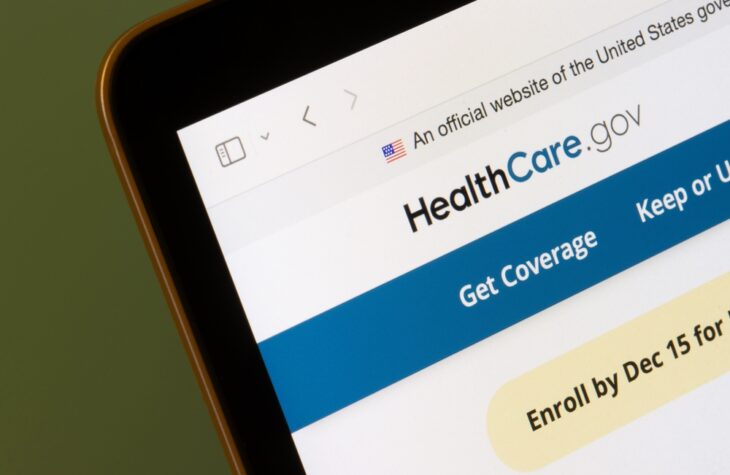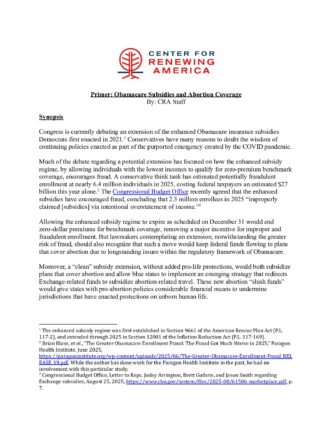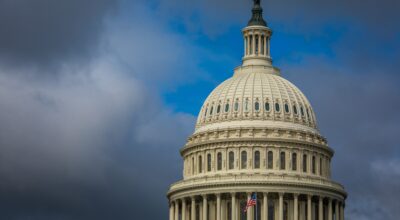
Primer: Obamacare Subsidies and Abortion Coverage

Lawmakers have many issues to contemplate when considering an extension of the enhanced subsidies, including the sizable cost and increased risks of fraud associated with an extension. But they should also recognize that a straight extension of the enhanced subsidy regime would continue to send federal funds to plans that cover abortion, while doing nothing regarding the emerging blue state strategy to circumvent pro-life protections.
Synopsis
Congress is currently debating an extension of the enhanced Obamacare insurance subsidies Democrats first enacted in 2021.1 Conservatives have many reasons to doubt the wisdom of continuing policies enacted as part of the purported emergency created by the COVID pandemic.
Much of the debate regarding a potential extension has focused on how the enhanced subsidy regime, by allowing individuals with the lowest incomes to qualify for zero-premium benchmark coverage, encourages fraud. A conservative think tank has estimated potentially fraudulent enrollment at nearly 6.4 million individuals in 2025, costing federal taxpayers an estimated $27 billion this year alone.2 The Congressional Budget Office recently agreed that the enhanced subsidies have encouraged fraud, concluding that 2.3 million enrollees in 2025 “improperly claimed [subsidies] via intentional overstatement of income.”3
Allowing the enhanced subsidy regime to expire as scheduled on December 31 would end zero-dollar premiums for benchmark coverage, removing a major incentive for improper and fraudulent enrollment. But lawmakers contemplating an extension, notwithstanding the greater risk of fraud, should also recognize that such a move would keep federal funds flowing to plans that cover abortion due to longstanding issues within the regulatory framework of Obamacare.
Moreover, a “clean” subsidy extension, without added pro-life protections, would both subsidize plans that cover abortion and allow blue states to implement an emerging strategy that redirects Exchange-related funds to subsidize abortion-related travel. These new abortion “slush funds” would give states with pro-abortion policies considerable financial means to undermine jurisdictions that have enacted protections on unborn human life.
Obamacare and Abortion Coverage
Section 1303 of Obamacare set parameters for state insurance Exchanges regarding abortion.4 States can, and some do, prohibit all Exchange plans from covering the procedure.5 Importantly, progressives crafted Obamacare specifically to avoid the full and longstanding Hyde Amendment prohibitions on taxpayer funding for abortion. They did this by self-appropriating the funds for the subsidies instead of subjecting the funding mechanism to the annual appropriations process, where Hyde protections apply.
But where states permit coverage of abortions beyond those for which federal funding is permitted by the federal Hyde Amendment—that is, abortions beyond those in cases of rape, incest, or to save the mother’s life—Section 1303 imposes requirements on insurers. For one, qualified health plans must “provide a notice to enrollees…at the time of enrollment,” that their health plan covers abortions.6
Other provisions relate to the flow of federal dollars to plans covering abortion. Plans “shall not use any amount attributable to” federal subsidies to pay for abortions not permitted under the Hyde Amendment.7 Instead, insurers must charge enrollees at least $1 monthly for abortion coverage, which must be kept in a separate account that only funds abortion procedures.8
Since Obamacare’s passage in 2010, pro-life groups have derided the Section 1303 mechanism as an accounting gimmick.9 Because money is fungible, any federal subsidy to reduce the out-of-pocket premium expenses of an insurance plan inherently makes the abortion portion of the policy more affordable, notwithstanding any accounting shell game spelled out in statute.
In September 2014, the Government Accountability Office released a report indicating that many insurers had not abided by the requirements laid out in Section 1303.10 Multiple insurers informed government auditors that they were not notifying enrollees that their plans covered abortions “at the time of enrollment,” as spelled out in the statute. Other insurers “did not round up the amount [for coverage of abortion] to the statutory minimum of $1 and, therefore, were not using this statutory minimum as a basis for determining premium amounts to collect from enrollees.”11 In addition, “fifteen issuers and the Washington Health Benefit Exchange…did not itemize the premium amount associated with non-excepted abortion services coverage on enrollees’ bills nor indicate that they send a separate bill for that premium amount.”12
GAO’s findings that insurers were not complying with the Section 1303 requirements led to a series of regulatory responses. In responding to the GAO report, the Obama Administration “acknowledge[d] that additional clarification may be needed,” and later offered “clarifying guidance” as part of a larger regulation, outlining “several ways” for insurers to “comply with the [Section 1303] requirements.”13
When it took office, the first Trump Administration released a guidance letter addressing Section 1303 compliance.14 The letter reminded insurers of their requirements under the law, and stated that “where we are charged with directly enforcing these statutory requirements” in the federally-run Exchange, “we intend to do so fully, beginning with the 2018 plan year.”15
The first Trump Administration followed this guidance up with a formal rulemaking process, completed in December 2019, that required insurers to send separate bills to, and collect separate payments from, enrollees for the abortion-related portion of their insurance coverage.16 The Biden Administration subsequently rescinded this policy upon taking office, in a final rule published in September 2021.17
Because of the myriad problems associated with the Section 1303 mechanism—inconsistent application and enforcement, along with the problems inherent in this sham accounting gimmick—a coalition of pro-life groups recently wrote to Congress calling for full Hyde Amendment protections in any bill addressing the expiration of Obamacare subsidies:
Any funding for Obamacare…whether through cost-sharing reductions [CSRs] or premium tax credits [PTCs], is forced taxpayer funding of abortion—unless such funds are definitively limited to coverage that excludes elective abortion.…
Under Section 1303, PTCs and CSRs pay for health care plans that cover abortion that are not allowable under Hyde.…When taxpayer dollars buy a plan that covers abortion, they are funding abortion. This means that any extension of [Obamacare] PTCs or CSRs by Congress must be protected by the true Hyde policy.…
The Trump [2019] policy rescinded by Biden maximized enforcement of Section 1303, which was all that could be done under the law. However, if Congress makes changes to [Obamacare] or extends [Obamacare] coverage, the changes must include complete application of Hyde policy.18
Adding full Hyde Amendment protections to the subsidy regime would merely restore a policy status quo that existed for decades before Obamacare, whereby federal taxpayer dollars do not flow to insurance plans that cover abortion.
Emerging Pro-Abortion Strategy
Recent developments demonstrate another major flaw in the Section 1303 accounting mechanism. Maryland has commandeered unused dollars in insurer accounts segregated for abortion coverage, as required under Obamacare, to fund its abortion industry. The move, which lawmakers want other pro-abortion states to adopt, will circumvent pro-life legislation that other states have enacted, by funding those residents’ travel to Maryland to receive an abortion.
On May 13, Gov. Wes Moore (D) signed a bill creating the Public Health Abortion Grant Program in Maryland.19 That law:
1. Directs the state Insurance Commissioner to confiscate “90% of the amount of the ending balance of the [insurer’s] segregated [Section 1303] account that exceeds disbursements for each of plan years 2014 through 2023,” along with the accrued interest on said funds;
2. Directs the Commissioner similarly to confiscate 90% of any future surplus in an insurer’s segregated Section 1303 account available at the end of the plan year, including any applicable interest;
3. Directs the confiscated funds into the new Public Health Abortion Grant Program, “to provide grants to improve access to abortion care clinical services for individuals in the state;”
4. Directs the Secretary of Health to “support equitable access to abortion care clinical services across the state,” by awarding grants to an entity that “employs health care practitioners” and “provides equitable access to abortion care clinical services for individuals without sufficient resources,” or an entity that “administers a fund to provide equitable access to abortion care clinical services for individuals without sufficient resources.”20
The executive director of Maryland Right to Life noted that the law “uses insurance premiums from insured women to abort the children of uninsured women.”21 However, the law goes well beyond redirecting dollars from insured women to fund the abortions of uninsured women. Because the measure allows funding for “individuals in the state” rather than residents of the state, and extends grant eligibility beyond abortion providers to abortion access groups, it takes money paid by Maryland residents to fund the abortions of women residing outside Maryland who travel to the state for their procedure.
One estimate suggested that Maryland’s Section 1303 mechanism takes in “about $3 million each year.”22 The legislation will divert $25 million in surplus funds accumulated since the Exchanges began operating in 2014, along with an estimated surplus of $2.5 million annually, to fund the abortion industry in Maryland.23
However, the potential impact of the legislation could well exceed the tens of millions of dollars that Maryland has already confiscated. One of the bill’s sponsors, Del. Lesley Lopez (D-Montgomery), invited other states to mimic the Old Line State:
Maryland has been a leader on a lot of reproductive bills for the past 30 years, and so in that way, this bill fits into that legacy. It’s also nationally significant, because there’s 25 or 26 other states that can take this model and run with it. We’re looking for California, Illinois, New York, those bigger states that are sitting on potentially hundreds of millions of dollars to take what we’ve done here in Maryland and implement it there.24
If other states follow Lopez’s suggestion, blue states would collectively have a large “slush fund” to fund abortion procedures, along with related travel.
Provisions in the recent budget reconciliation measure prohibiting federal dollars from flowing to Planned Parenthood and other designated abortion providers will save an estimated $53 million over ten years, according to the Congressional Budget Office.25 By way of comparison, the Maryland legislation alone will, over the same 10-year period, provide roughly the same amount of resources to the abortion industry that Congress defunded in legislation passed in July.
If one or more states enact legislation similar to Maryland’s, as one of the bill’s sponsors has suggested, then the abortion industry could experience a financial windfall far greater than any reduction in funding passed by the current Congress. Moreover, by funding what amounts to an abortion tourism industry, these dollars would actively circumvent and undermine the protections that many states have enacted to create a culture that respects the unborn in their states.
Important Debate
Rep. Jen Kiggans (R-VA) recently introduced a bill (H.R. 5145) to extend the enhanced Obamacare subsidies, currently scheduled to expire on December 31, for one additional year.26 As introduced, the legislation includes no changes to Section 1303, leaving undisturbed Maryland’s emerging strategy to fund abortions for out-of-state residents.27 Her office has not said why her bill excluded pro-life protections, or whether she would support including them as part of any legislative package.
Lawmakers have many issues to contemplate when considering an extension of the enhanced subsidies, including the sizable cost and increased risks of fraud associated with an extension. But they should also recognize that a straight extension of the enhanced subsidy regime would continue to send federal funds to plans that cover abortion, while doing nothing regarding the emerging blue state strategy to circumvent pro-life protections. In so doing, an extension without full Hyde Amendment protections would effectively reverse this Congress’s move to defund abortion providers, while undermining states that have gone to great lengths to protect unborn life within their borders.
Endnotes
1. The enhanced subsidy regime was first established in Section 9661 of the American Rescue Plan Act (P.L. 117-2), and extended through 2025 in Section 12001 of the Inflation Reduction Act (P.L. 117-169).
2. Brian Blase, et al., “The Greater Obamacare Enrollment Fraud: The Fraud Got Much Worse in 2025,” Paragon Health Institute, June 2025, https://paragoninstitute.org/wp-content/uploads/2025/06/The-Greater-Obamacare-Enrollment-Fraud_RELEASE_V4.pdf. While the author has done work for the Paragon Health Institute in the past, he had no involvement with this particular study.
3. Congressional Budget Office, Letter to Reps. Jodey Arrington, Brett Guthrie, and Jason Smith regarding Exchange subsidies, August 25, 2025, https://www.cbo.gov/system/files/2025-08/61506-marketplace.pdf, p. 7.
4. Section 1303 of the Patient Protection and Affordable Care Act (P.L. 111-148), codified at 42 U.S.C. 18023.
5. 42 U.S.C. 18023(a). In the Exchanges’ first year of operation, a total of 17 states prohibited coverage of all non-excepted abortion services (i.e., abortions to which the Hyde Amendment did not apply), while a further six states permitted coverage of non-excepted abortion services “only in limited circumstances.” See Government Accountability Office, “Health Insurance Exchanges: Coverage of Non-Excepted Abortion Services by Qualified Health Plans,” Report GAO-14-742R, September 15, 2014, https://www.gao.gov/assets/gao-14-742r.pdf, Table 1, p. 12.
6. 42 U.S.C. 18023(b)(3).
7. 42 U.S.C. 18023(b)(2)(A).
8. 42 U.S.C. 18023(b)(2).
9. See for instance Susan B. Anthony Pro-Life America et al., Letter to Members of Congress, September 3, 2025, https://s3.amazonaws.com/pub-attachments/15db750c-dbdd-4b7b-806f-b5129a6b22ae.pdf.
10. GAO, Report GAO-14-742R.
11. Ibid., p. 7.
12. Ibid., p. 7.
13. Ibid., Enclosure III, p. 20; Department of Health and Human Services, “Patient Protection and Affordable Care Act: HHS Notice of Benefit and Payment Parameters for 2016,” Federal Register February 27, 2015, https://www.govinfo.gov/content/pkg/FR-2015-02-27/pdf/2015-03751.pdf, p. 10841.
14. Randy Pate, “CMS Bulletin Addressing Enforcement of Section 1303 of the Patient Protection and Affordable Care Act,” October 6, 2017, https://www.cms.gov/CCIIO/Resources/Regulations-and-Guidance/Downloads/Section-1303-Bulletin-10-6-2017-FINAL-508.pdf.
15. Ibid.
16. Department of Health and Human Services, “Patient Protection and Affordable Care Act: Exchange Program Integrity,” Federal Register December 27, 2019, https://www.govinfo.gov/content/pkg/FR-2019-12-27/pdf/2019-27713.pdf.
17. Departments of Treasury and Health and Human Services, “Patient Protection and Affordable Care Act: Updating Payment Parameters, Section 1332 Waiver Implementing Regulations, and Improving Health Insurance Markets for 2022 and Beyond,” Federal Register September 27, 2021, https://www.govinfo.gov/content/pkg/FR-2021-09-27/pdf/2021-20509.pdf.
18. SBA Pro-Life America et al., Letter to Congress.
19. Maryland SB 848, Chapter 436, text available at https://mgaleg.maryland.gov/2025RS/Chapters_noln/CH_436_sb0848t.pdf.
20. Ibid.
21. Scott Maucione, “Maryland Taps Affordable Care Act Fund to Help Pay for Abortion Care,” National Public Radio July 17, 2025, https://www.npr.org/sections/shots-health-news/2025/07/17/nx-s1-5459881/maryland-abortion-fund-affordable-care-act.
22. Ibid.
23. Ibid.
24. Quoted in Ibid.
25. Section 71113 of the One Big Beautiful Bill Act (P.L. 119-21); Congressional Budget Office, Estimated Budgetary Effects of Public Law 119-21, July 21, 2025, https://view.officeapps.live.com/op/view.aspx?src=https%3A%2F%2Fwww.cbo.gov%2Fsystem%2Ffiles%2F2025-07%2F61570-pl119-21-2025Recon-CLB.xlsx&wdOrigin=BROWSELINK.
26. Office of Rep. Jen Kiggans, “Kiggans, Suozzi Lead Effort to Prevent Soaring Health Care Premiums for Thousands of Virginians,” September 4, 2025, https://kiggans.house.gov/posts/kiggans-suozzi-lead-effort-to-prevent-soaring-health-care-premiums-for-thousands-of-virginians.
27. H.R. 5145 (119th Congress), the Bipartisan Premium Tax Credit Extension Act.




